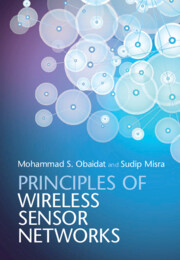Book contents
- Frontmatter
- Dedication
- Contents
- Preface
- 1 Introduction to wireless sensor networks
- 2 Inside a wireless sensor node: structure and operations
- 3 Wireless sensor network applications: overview and case studies
- 4 Medium access in wireless sensor networks
- 5 Routing in wireless sensor networks
- 6 Transport protocols for wireless sensor networks
- 7 Localization and tracking
- 8 Topology management and control
- 9 Performance evaluation of wireless sensor networks
- 10 Security issues in wireless sensor networks
- 11 Wireless mobile sensor networks
- 12 Wireless multimedia sensor networks
- 13 Underwater sensor networks
- 14 Wireless underground sensor networks
- References
- Subject index
- References
11 - Wireless mobile sensor networks
Published online by Cambridge University Press: 05 December 2014
- Frontmatter
- Dedication
- Contents
- Preface
- 1 Introduction to wireless sensor networks
- 2 Inside a wireless sensor node: structure and operations
- 3 Wireless sensor network applications: overview and case studies
- 4 Medium access in wireless sensor networks
- 5 Routing in wireless sensor networks
- 6 Transport protocols for wireless sensor networks
- 7 Localization and tracking
- 8 Topology management and control
- 9 Performance evaluation of wireless sensor networks
- 10 Security issues in wireless sensor networks
- 11 Wireless mobile sensor networks
- 12 Wireless multimedia sensor networks
- 13 Underwater sensor networks
- 14 Wireless underground sensor networks
- References
- Subject index
- References
Summary
As we discussed in the previous chapters, a wireless sensor network (WSN) consists of tiny nodes with limited resources. The nodes sense their surroundings and communicate with the sink(s) through multi-hop mechanisms. Nodes are powered by batteries. Often the batteries of a node are not of the rechargeable type or the replacement of the batteries, after exhaustion of battery power, is not a suitable option. Generally, static or stationary WSNs are used. If all nodes of a WSN are stationary, then the WSN is referred to as the stationary wireless sensor network (SWSN), as discussed in [1]. Some limitations of a SWSN can be overcome by using mobile nodes. As an example, if the battery power of a node becomes exhausted during operation, another node can move to the position of the former node and provide services offered by that exhausted node. If all nodes, or at least some, of a WSN are capable of moving, then this type of WSN is called a mobile wireless sensor network (MWSN). Obviously, a mobile node must have the capabilities of communication, computation, and locomotion.
Some of the drawbacks of SWSNs are discussed here. In WSNs, the sensor nodes communicate with the sink or base station through multi-hop mechanism. Moreover, the communication pattern is many-to-one. As a consequence, nodes nearer to the sink forward their own data, as well as data from other more-distant nodes. An example of an SWSN, where sensor nodes are deployed randomly, is shown in Figure 11.1. In the presence of static base station(s), a WSN encounters the funneling/bottleneck effect and the hotspot problem [2].
Information
- Type
- Chapter
- Information
- Principles of Wireless Sensor Networks , pp. 248 - 281Publisher: Cambridge University PressPrint publication year: 2014
